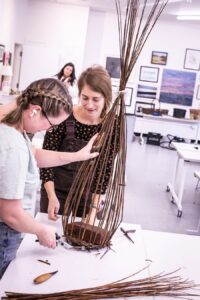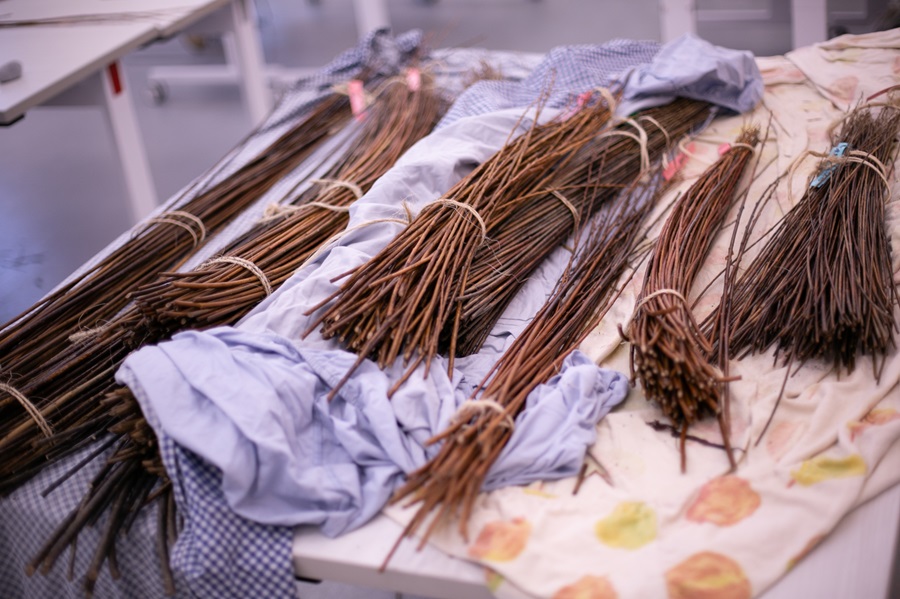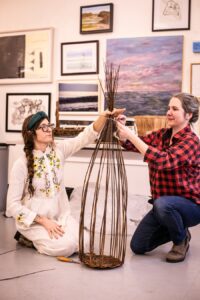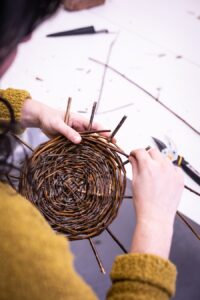On a snowy Saturday afternoon, seven women gather in a community room at the Provincetown Commons, picking up bunches of brown sticks from a table in the corner before settling in at tables. They’re here to weave the thin, flexible, sweet-smelling willow branches into baskets.

Elspeth Hay, who helped organize the group and is now teaching it alongside Commons director Lesley Marchessault, holds a small circular basket-bottom. It’s mid-construction and looks like a wheel, with spokes extending from its center. She pulls willow twigs over and under the spokes, filling in the gaps as they go around. This part of the process is called twining. When one stick reaches its end, Hay places another, slightly overlapping the first, to continue the line.
Hay first learned the craft a couple of years ago at a workshop in Gloucester with Mary Lauren Fraser, who lives in Turners Falls and makes willow caskets for green burials. Fraser encouraged the workshop participants to go home and make another basket as soon as possible in order to commit the process to muscle memory, Hay says. She ordered wood from Living Willow Farm in Ohio and invited Marchessault, who lives across the street from her in Wellfleet, to join in trying the craft.
“The baskets we made looked nothing like the one I had made in the workshop,” says Hay. For Marchessault, “it was a mild disaster.” So, Hay invited Fraser to teach a class in Provincetown. It was a hit. A few months later, she says, “we asked everyone who did the original workshop if they wanted to buy more willow and weave together again.” Everybody said yes.

Willow wood for weaving comes in bundles of dry rods that must be soaked in water for about a week to become pliable enough to work with. Some of the branches are six feet tall. Hay uses a fat PVC pipe as a vessel for the soaking. She fills the pipe in the shower, inserts the branches, and puts a cap on top. Smaller branches can go in the bathtub.
“You soak the wood for one day per one foot of length,” says Hay. “Once you can bend it at 90 degrees, and it doesn’t break, then you know it’s ready.” Weavers then have a week to work with the twigs before they get too dry again.

Lauren Leveque, who drove up to Provincetown from Woods Hole for the workshop, dutifully twines the base of her basket: over, under, over, under. The basket she made in that first workshop with Fraser sits on the table in front of her like a muse. “I think I’ll use it for a harvest basket,” she says. “I’m a big vegetable gardener at home, and I gather herbs. It’s satisfying to make something that gets used.”
At the next table, Vida Richter, who lives in Truro, is making a smaller basket than the one she wove before. “I’ve had to start over three times,” she says. But she keeps at it. Her basket at home holds her youngest daughter’s toys — “I’m hoping to use this one for myself.”
The room is mostly quiet aside from an occasional crack of breaking wood, soft murmurs of frustration or satisfaction, or the snip of a pair of pruners.

“When we first got together, I thought we’d be chatting more,” says Nicole Gelinas of Truro. The work requires focus, though. “It’s quiet work. You’re doing something on your own, but together.”
Gelinas’s basket is at the “birdcage” stage. She inserts longer, thicker branches, called uprights, into the flat base of her basket. Suddenly the small object looks like a giant spider, its legs reaching out in every direction.
Nicole Cormier, also here from Truro, is working on the floor. With a knife, she lightly cuts the base of each upright and gently bends it up. Two sticks break with loud snaps. “There are definitely a lot of feelings that come up with being a beginner at something,” says Cormier. “But working through those feelings with a group is a beautiful process.” She carefully removes the broken sticks and replaces them. Then, Marchessault helps her wrangle the uprights into a cage shape, tying the top with a piece of twine. The next step will be weaving rods between the uprights, forming the sides of the basket.

Alyssa Staker of Wellfleet is still working on weaving her base. The work is meditative for her. “It really shuts down the active mind,” she says. Weaving a large basket can take as long as 10 hours, so the group will reconvene tomorrow.
When twining, it’s important to stay attentive — sometimes, one of the slender sticks will form a kink, messing with the weave’s smooth flow. Once there, the kink will remain. “Kinks are forever,” says Hay.
The craft of basket weaving is an ancient one. “I find it mind-boggling that someone figured this out,” says Hay. “I’m sure it wasn’t just one person but generation after generation slowly refining it.”
After the baskets are completed, they must be cured for three to four weeks to dry out from the soak. “Once they’re dry, they’re incredibly strong,” says Hay. “You can fill them up with rocks, no problem.
“You finish it and you say, ‘Wow, I had a pile of sticks, and now I have a strong, beautiful, useful container,’ ” says Hay. “The clippings make great kindling, too.”
